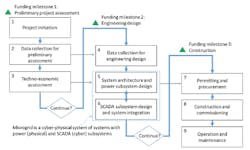Building the case for the standardization of microgrid platforms for the DOD
The US Department of Defense (DOD), through its Environmental Security Technology Certification Program (ESTCP), has identified microgrids as a key technology for increasing security, energy efficiency and resilience at new and existing military installations.
The advantages are clear. Microgrids can reduce the energy and physical footprint of military installations. This in turn reduces the reliance on and impact to local communities while improving the likelihood of uninterrupted power despite disruptions on local utility networks. Microgrids can reduce energy costs and lessen dependence on fuel supplies, thus increasing resilience.
Specifically, the ESTCP has called for a scalable microgrid solution that can reduce the costs and time associated with the design of such systems. However, scalability is not easily applicable to microgrids, as they can only be standardized to a certain point. That’s because the landscape for each location can be unique and can require an equally unique solution to maximize benefits.
In a quest for the optimum solution, the DOD ESTCP financed the Rapid and Repeatable Modeling and Design of Secure and Resilient Microgrids (Rapid-Resilient-Microgrid) project, working with Xendee in collaboration with Arizona State University, Pacific Northwest National Laboratory, Lawrence Livermore National Laboratory, California Polytechnic Institute San Luis Obispo, and Naval Facilities Engineering Systems Command (NAVFAC).
Demonstrating the value of a standardized approach to DOD microgrid installations
All of the following variables found at any given military installation require a distinct, holistic modeling approach for microgrid system design.
- Critical operations.
- Local tariffs.
- Climate conditions.
- Demand characteristics.
- Dependency on external energy and power infrastructure.
- Specific funding mechanism.
- Existing assets.
The lack of a standardized modeling methodology and a transparent approach leaves no clear starting point for the design process.
To this end, Xendee and its partners engaged in a demonstration of a standardized, transparent, streamlined and repeatable platform solution that addresses the capabilities requested by the ESTCP in the design of microgrids using the Xendee platform. Designed to achieve DOD goals by focusing on unique situations at real installations, the demonstration took place on three military installations with disparate scale, mission, geography and regulation.
Rationale for site selection and study focus
Each of the three microgrid demonstration sites was chosen for distinctly different reasons and objectives.
The Naval Submarine Base Kings Bay at Kings Bay, Georgia, is a large military installation of strategic importance. It’s the home port of the US Navy Fleet’s ballistic missile nuclear submarines that are capable of being armed with Trident missiles. Here, highly granular electric and microgrid data was available, with several planned installation upgrades requiring technical assessment. The focus was on examining ongoing upgrades to the installation to determine feasibility, return and alternatives.
The US Army Garrison Bavaria, Grafenwöhr/Vilseck, Germany, is a collection of installations that are strategically important for training infantry on European soil. In an attempt to modernize its training facilities, the site tested a standard training facility design that can easily scale to different installations. At this site, highly granular energy data was available as well as prior microgrid design that was used for benchmarking. These installations afforded a range of sizes and use cases. The study focused on providing energy and power design for a state-of-the-art and standardized training facility that runs completely on electricity.
The Naval Base San Diego is a strategic training facility within the Pacific Naval Command. It houses the LEED-certified, state-of-the-art Littoral Combat Ship Training Facility, which operates continuously. Without getting trained at this facility, sailors are not allowed to be deployed. However, the state-of-the-art, mission-critical training facility was hampered by aging infrastructure. This third demonstration examined installing a microgrid on a single building, as opposed to installing new cabling to the building.
The microgrid technology at play
The Xendee platform used in these demonstrations consists of an economic optimization and power system solver coupled tool built on more than 20 years of research and development. It’s cloud based and hosted on secure remote or localized servers. Within this project, Xendee completed the Cybersecurity Maturity Model Certification process in order to be able to be used by the DOD.
The purpose was to demonstrate the end-to-end microgrid design and implementation platform coupled with a DOD-tailored training program to improve microgrid literacy. The Xendee platform is an informed decision-making technology that expands and builds upon well-established scientific models of microgrid power and energy behavior. It creates a single user platform around these tools, combines it with databases and interfaces to external tools (e.g., solar data and tariff data), making it easier to use – streamlining the whole microgrid design and implementation process. When it comes to guaranteeing the best solution for microgrid energy provisions, Xendee employs a mixed integer linear optimization model to determine the optimal mix, capacity, placement, power flow and operation of resources within a new or existing microgrid under real constraints such as climate, regulations, utility structure and financial realities.
The Xendee platform was used to assess a number of technologies for installation at the three use-case sites, including solar PV, battery energy storage, diesel generators, heat pumps, and gas combined heat and power engines. The proper sizing of cables and transformers according to national standards was also a factor.
The seven-step microgrid demonstration in action
At each of the three military installations, the first three steps were meant to mimic the design phase of a DOD microgrid. This provided real deliverables to the installations at the end of stage three, along with an assessment in terms of time and cost savings of the demonstration. Step four synthesized the learning made in those three steps, distilling and documenting the repeatable and standard approach. Step five crafted a training program around the work performed in the first four steps. Step six ensured that Xendee met the minimum cybersecurity requirements for operation within the DOD. Step seven focused on technology transfer and project outreach while also providing demonstration to general management.
Source: Xendee
Methodology for creating a standard and repeatable approach
The goal of this demonstration was to provide exposure to the current practices of microgrid design and implementation to the project teams while ensuring that the Xendee platform matches those practices.
A lack of standardization was noticed early on in the process. The challenge was exacerbated by a disconnect from the top to bottom of the DOD planning and implementation process. Specifically, it was clear that the people in charge of getting microgrids built were not equipped with the tools or network to do so.
Part of the problem lay in the fact that this kind of responsibility typically falls on the shoulders of energy managers or members of the Department of Public Works. These already extremely busy staffers typically did not have the bandwidth needed to carry out such designs. Those that had bandwidth generally did not have a tool capable of doing accurate analysis. And, in most cases, they also did not have a network that could provide this type of analysis.
This in turn leads to a massive reliance on third-party designers, typically engineering procurement and construction (EPC) firms, which are outside of the DOD umbrella, to provide such analysis. This then creates an expensive and delayed design process with a single EPC often carrying out the entire process.
With all this in mind, this microgrid demonstration presented the opportunity to counter this unnecessary process through the creation of a standard repeatable design approach that is branch and tool independent. As shown below, the standard design of a microgrid typically follows three key milestones for funding and engineering, but this process can also change depending on the procurement method used by the organization. For instance, some methods (design-bid-build) may incorporate a stage for bidding amongst multiple vendors while some leave the ownership of the microgrid in the hands of the provider — buying the energy instead as a service on an energy savings performance contract.
Source: Xendee
Designing and implementing a tailored training program for the DOD
To round out each site’s demonstration activity, Xendee and its partner Arizona State University created a DOD-specialized training curriculum designed to train service members at participating installations from the ground up on using the Xendee software. The primary training objective was to introduce DOD participants to a standard, repeatable process for building and interpreting microgrid models.
Training sessions were organized around key steps (e.g., data collection or power flow analysis) in the microgrid design process to foster a foundational knowledge base for creating microgrid models and provide best practices for developing advanced models. Each training session was designed around learning objectives directly pertaining to these topics and supported by opportunities for participants to engage with hands-on, real-world modeling examples and tasks.
Specific sessions included Microgrid Design for Resiliency, Introduction to Microgrid Modeling in Xendee and Advanced Microgrid Modeling Training. Training was conducted individually, in small groups and virtually when required. Discussion and exploration were encouraged with guiding questions.
Feedback was collected and training content iterated based on needs expressed by program participants. As this sample of assessments of the training experience convey, the response from trainees was very positive: “A great class! Xendee is a very powerful and useful tool!” “It was a great introduction and looks like a very useful tool.” “Excellent overview of an extremely powerful tool.”
This training curriculum is now available for DOD staff with classes provided on a continuous basis.
Demonstrations show improvement in current practices with time and cost reductions
The standardized microgrid design and implementation approach developed in this project highlights all stages of the microgrid design process. The creation of a secure templated data transfer mechanism allows DOD installations to easily and clearly send over the needed data for modeling. This in turn boosts the security of the platform and models being studied.
The Xendee platform provides a standardized microgrid design approach that cuts microgrid design time and expenses with a methodology that is readily scalable across the DOD.
In terms of budget, the average costs to complete even the most complex modeling using Xendee resulted in less than 1% of total project costs. A survey of publicly available microgrid feasibility and design cost data was conducted and compared to Xendee design and modeling costs. Xendee design modeling costs averaged ~13% of the industry average.
Additional time savings were realized as well, with modeling taking weeks – not months – in person hours.
To learn more, read the report: DoD Standardized Platform to Guide Rapid and Repeatable Modeling and Design of Secure and Resilient Microgrids (Rapid-Resilient-Microgrid) SERDP/ESTCP Project # EW20-B8-5271.
Michael Stadler is chief technology officer at Xendee. Zack Pecenak is the lead engineer at Xendee. Read more about this project here.




